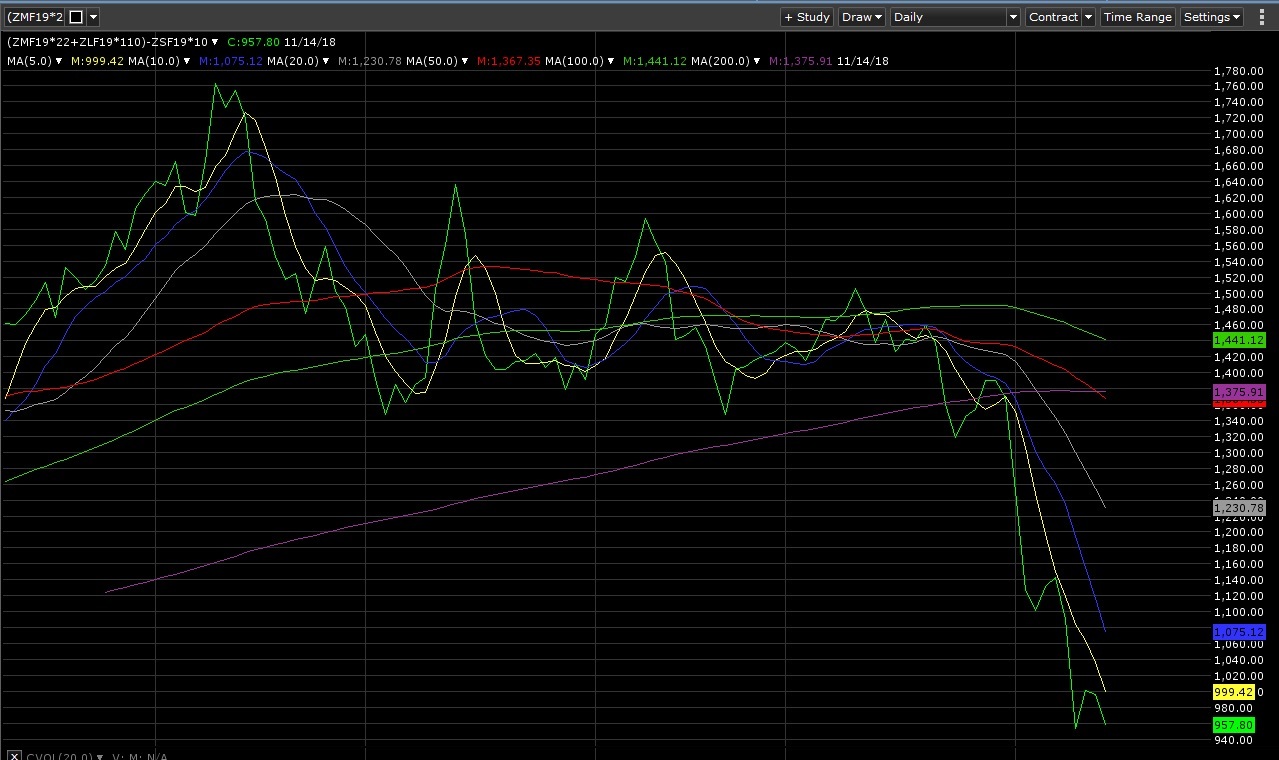
TRADING COMMODITY FUTURES AND OPTIONS INVOLVES SUBSTANTIAL RISK OF LOSS AND MAY NOT BE SUITABLE FOR ALL INVESTORS. YOU SHOULD CAREFULLY CONSIDER WHETHER TRADING IS SUITABLE FOR YOU IN LIGHT OF YOUR CIRCUMSTANCES, KNOWLEDGE AND FINANCIAL RESOURCES.
On Thursday the National Oilseed Processors Association (or NOPA) will release their crush figures and the market couldn’t be more unsure about how active the soybean crush was in October. Looking at the trade guesses there is about a thirteen-million-bushel range of estimates. We know that crush margins began to fall at the end of November but did processors see that coming or did we set a new crush record?
The monthly NOPA crush report reflects the monthly activity for thirteen of the largest soybean processors in the US, accounting for 95% of the US soybean crush. The USDA also releases crush data, but it comes about 2 weeks later and is somewhat predictable once we have seen NOPA crush numbers. Knowing the monthly crush activity is important to the soybean market because on any given year the crush accounts for about half of our soybean usage with exports taking the other half.
With exports being a big question mark this year due to the trade spat with China the soybean crush becomes a little more important. For months the soybean complex was offering processors abnormally large margins to crush soybeans. However, at the beginning of October crush margins took a significant drop. The question is why? And, Thursday’s report may offer some insight.
At 160.8 million bushels the September NOPA soybean crush was a new record by a LONG shot. The previous September record of 139.8 million bushels was set back in 2007. With better than normal crush margins and an ample supply of soybeans this makes a lot of sense. At the time it seemed that the only limitation of growing crush demand (and offsetting some lost export demand) was the capacity of our soybean processors. However, the recent sharp drop in margins could be suggesting that demand for soybean meal may not be as robust as once hoped.
Trade expectations for the October NOPA crush range from 165 million bushels to 178 million. Anything within this range (or above) would break the current October record of 164.6 set back in 2016, the question seems to be “by how much?” The record crush for any month came in March of 2018 at 171.9 million bushels.
The concern is, based on the drop in crush margins, that the crush has been running so strong in the last few months that we have now flooded the market with soybean meal. If this is the case it could take some of the seasonal strength in soybeans away. In some years soybean meal prices start to spike because of a dramatic slowdown in crush during September and early October. This can leave the market short supplied and soybean meal prices work to incentivize processors to add supply quickly.
Strangely, while a strong October NOPA crush number will mean that we are using more soybeans it might not be overly bullish for the market. A lower than expected crush could concern end-users and encourage them to get more aggressive on filling needs. If the crush comes in strong and shows ample meal stocks it could take away another positive influence on seasonal tendency.
We have complimentary 2018 commodity reference calendars available. They are a little bigger than pocket sized and very useful if you follow markets. You can sign up for yours here - http://www.zaner.com/offers/calendar.asp (Shipping to the US only)
Give us a call if you would like more info on the strategies we are using or if you would like to set up an account to put a plan in action. Ted Seifried - (312) 277-0113. Also, feel free to give me a call or shoot me an email if you would like to talk about your marketing plan, the markets, weather, or just to visit. Find me on twitter - @thetedspread
Producers looking to hedge all or a portion of their production may be rather interested in some of the options / options-futures strategies that I am currently using.
In my mind there has to be a balance. Neither technical nor fundamental analysis alone is enough to be consistent. Please give me a call for a trade recommendation, and we can put together a trade strategy tailored to your needs. Be safe!
Ted Seifried (312) 277-0113 or tseifried@zaner.com
Additional charts, studies, and more of my commentary can be found at: http://markethead.com/2.0/free_trial.asp?ap=tseifrie
Sign up for our Morning Ag Hedge newsletter! Sign up here: http://www.zaner.com/landing/ag_hedge_newsletter.asp
FOR CUSTOMERS TRADING OPTIONS, THESE FUTURES CHARTS ARE PRESENTED FOR INFORMATIONAL PURPOSES ONLY. THEY ARE INTENDED TO SHOW HOW INVESTING IN OPTIONS CAN DEPEND ON THE UNDERLYING FUTURES PRICES; SPECIFICALLY, WHETHER OR NOT AN OPTION PURCHASER IS BUYING AN IN-THE-MONEY, AT-THE-MONEY, OR OUT-OF-THE-MONEY OPTION. FURTHERMORE, THE PURCHASER WILL BE ABLE TO DETERMINE WHETHER OR NOT TO EXERCISE HIS RIGHT ON AN OPTION DEPENDING ON HOW THE OPTION'S STRIKE PRICE COMPARES TO THE UNDERLYING FUTURE'S PRICE. THE FUTURES CHARTS ARE NOT INTENDED TO IMPLY THAT OPTION PRICES MOVE IN TANDEM WITH FUTURES PRICES. IN FACT, OPTION PRICES MAY ONLY MOVE A FRACTION OF THE PRICE MOVE IN THE UNDERLYING FUTURES. IN SOME CASES, THE OPTION MAY NOT MOVE AT ALL OR EVEN MOVE IN THE OPPOSITE DIRECTION.
